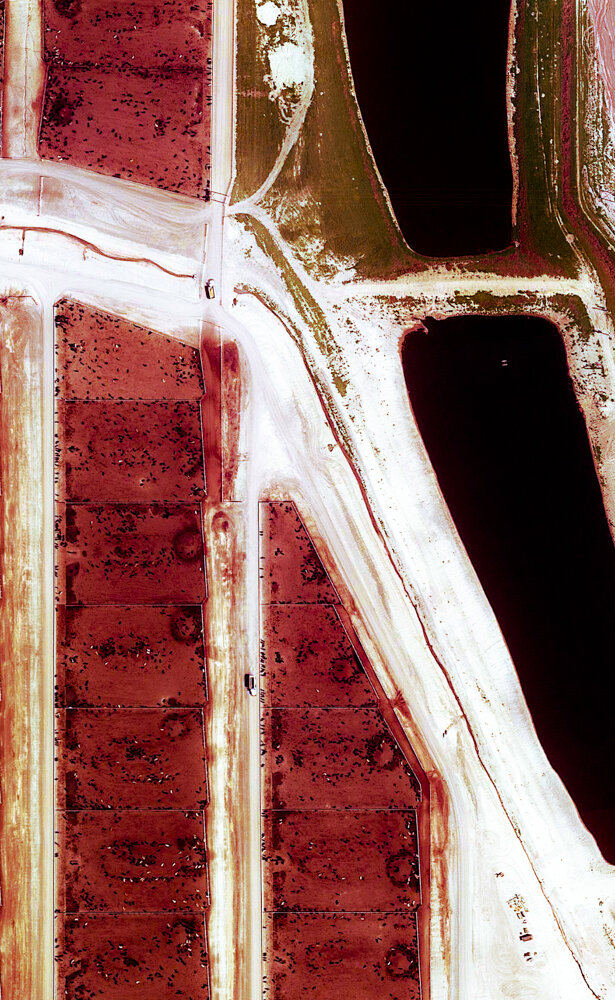Poignant Pics no. 29: On Justen Ahren's "Feedlot, Lubbock, TX"
Welcome to no. 29 in our series Poignant Pics where our editor, Diana Nicholette Jeon, writes what she experienced upon first encounter with an image.
Feed Lot, Lubbock, TX
Gone to Texas. All I Need is a Ride.
I was scrolling Facebook recently and happened upon a group of deeply pigmented abstract images along with an exhibition announcement. My first reaction was “Lovely paintings.” And then it registered for me that it had said photographs. It was so different than the black and white photographs of the American West and Europe usually created by Justen Ahren. I just had to know how these works that read like prints or paintings but were photographs had been created! I was intrigued enough to click through to the gallery site and learn more.
I ‘met’ Justen some years ago via social media. He always stuck in my thoughts because he is one of the hardy souls that reside full-time on Martha’s Vineyard, a place deeply embedded in my deceased mother’s heart (and mine.) Ahren is a poet who founded the acclaimed Noepe Center for Literary Arts, named one of the top 20 residencies in the country, but later found himself including photography to create multi-layered works consisting of both words and images.
I’ve included an excerpt from his artist statement:
“A couple of years ago, driving across West Texas with my daughter, who was returning from a semester at college, I was struck by the landscape of fracking sites, feedlots, and vast, harrowed fields. I made a few photographs and vowed to return to document the intensive, and often brutal human activity upon the land: road cuts, well sites, overgrazing, agriculture.
Then the pandemic hit and, like everyone, I was limited in my work. In order to satisfy my need to revisit West Texas, I one day got on Google Earth. The virtual journey was supposed to research for a future trip when lockdown lifted. I would locate the places I wished to photograph.
When I began, I was startled to find instead of scars, degradation, ugliness; an often surreal, powerful, and exquisite landscape that by turns looks like silk tapestries, ancient scripts, gorgon knots, mandalas, weaving on rugs or baskets.
Like most of my work, I’m interested in finding and making beauty from places of violence, moments of damage, circumstances of desolation. A landscape often brutalized and altered by machines and industrial agriculture here become brushstrokes, gold-threaded tapestries, angel hair, circuitry, sacred, repeating geometric symbols.
This work owes a large debt—my heart and eyes also—to the work of innovative Italian photographer, Mario Giacomelli. Giacomelli captured in the furrowed landscapes of his native country, the spirit of the land, its writing, and speaking.”
After composing an image on Google Earth, he ‘captures’ it and develops it further using Lightroom modules he created specifically to highlight the distinct tonality and texture of the topography of West Texas. (Interestingly, the module will only work correctly for the specific landmass it was created to ‘develop’.)
The work is painterly and ambiguous, rife with textures that could have been created using sugar lift and acid on metal yet weren’t. However, as you continue to look deeper, you begin to see beyond the texture and to the actual lands he “photographed.” It can be all too easy to make abstract work with no intent or content other than abstraction as the sole goal. It’s more difficult to do it via distance. In the time of COVID, when it’s been common to be overwhelmed by loss and destruction, it’s intriguing to find someone who used the time and technology to travel where he intended to go physically to take on destruction and find the beauty within. It’s also rather overwhelming to see how Ahren has created work that is meant to jump off the page, to make you question the content and meaning strictly via looking. I guess it is a natural evolution for a poet, though, one who does the same thing with his words.
Bravo, Justen. I hope to see more of these explorations, whether created on-site or on Google Earth, as we emerge from our capsules of COVID isolation.
— Diana Nicholette Jeon
Artist Bio
Justen Ahren is a poet, photographer, musician, and teacher who lives on Martha’s Vineyard. He has published two collections of poetry, A Strange Catechism, and A Machine For Remembering. Justen came to photography in 2016 as a way to document the refugee crises in Europe when language and music alone felt inadequate. The resulting work was 2018’s multi-media theater performance, The War for the Valley. His current photographic work, The Earth Tends To Beauty, employs drone and satellite imagery to create painterly photographs of plowed fields and feedlots whose power and symbolism recall sacred geometries and images humans have woven into baskets and rugs from the ancient past.
Mr. Ahren has exhibited work at the Feldman Family Gallery, Featherstone Center for the Arts, and at The Exodus Institute’s Refugee and Migrant Film Festival. His images also have appeared in numerous art journals, including, most recently, Cold Mountain Review and HocTok, as well as the covers of several books. More of his work can be seen at Justenahren.com and on Instagram and Facebook.
Author Bio
Diana Nicholette Jeon is an award-winning artist based Honolulu, HI-based artist working primarily with lens-based media. Her work has extensively exhibited both internationally and nationally in solo and group exhibitions. Jeon holds an MFA from UMBC.

